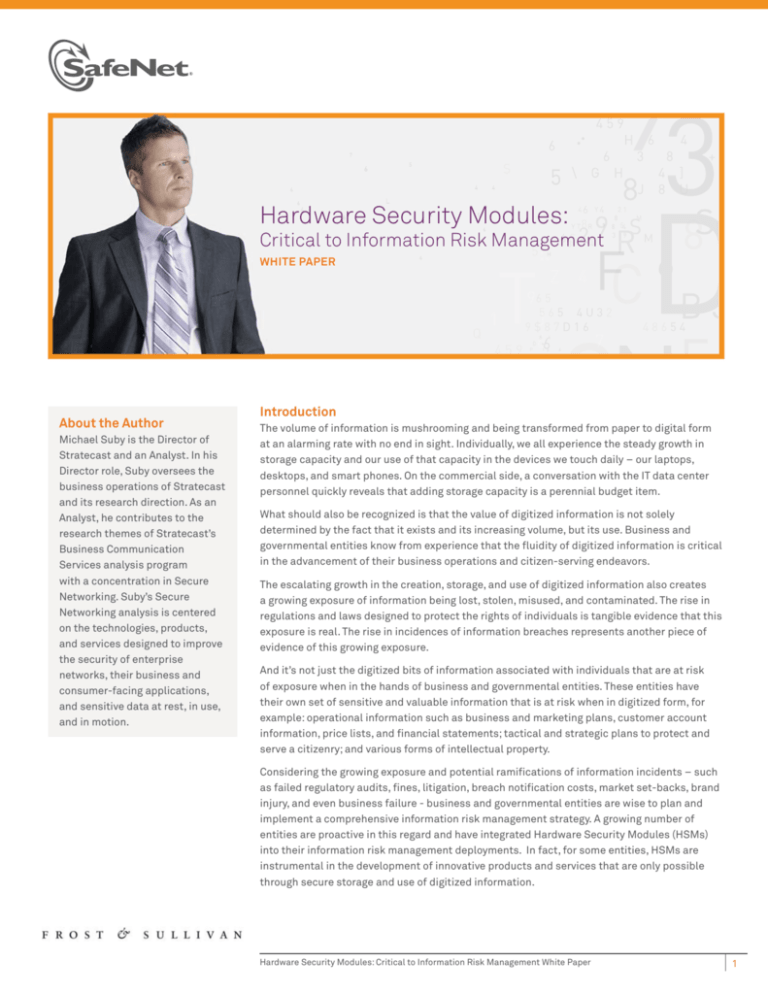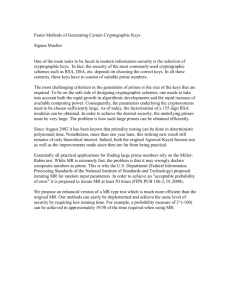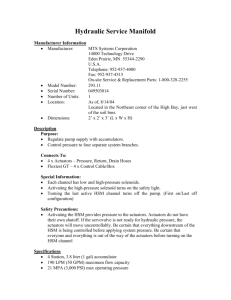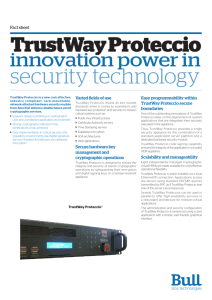
Hardware Security Modules:
Ha
Critical to Information Risk Management
Cr
WHITE PAPER
WH
About the Author
Michael Suby is the Director of
Stratecast and an Analyst. In his
Director role, Suby oversees the
business operations of Stratecast
and its research direction. As an
Analyst, he contributes to the
research themes of Stratecast’s
Business Communication
Services analysis program
with a concentration in Secure
Networking. Suby’s Secure
Networking analysis is centered
on the technologies, products,
and services designed to improve
the security of enterprise
networks, their business and
consumer-facing applications,
and sensitive data at rest, in use,
and in motion.
Introduction
The volume of information is mushrooming and being transformed from paper to digital form
at an alarming rate with no end in sight. Individually, we all experience the steady growth in
storage capacity and our use of that capacity in the devices we touch daily – our laptops,
desktops, and smart phones. On the commercial side, a conversation with the IT data center
personnel quickly reveals that adding storage capacity is a perennial budget item.
What should also be recognized is that the value of digitized information is not solely
determined by the fact that it exists and its increasing volume, but its use. Business and
governmental entities know from experience that the fluidity of digitized information is critical
in the advancement of their business operations and citizen-serving endeavors.
The escalating growth in the creation, storage, and use of digitized information also creates
a growing exposure of information being lost, stolen, misused, and contaminated. The rise in
regulations and laws designed to protect the rights of individuals is tangible evidence that this
exposure is real. The rise in incidences of information breaches represents another piece of
evidence of this growing exposure.
And it’s not just the digitized bits of information associated with individuals that are at risk
of exposure when in the hands of business and governmental entities. These entities have
their own set of sensitive and valuable information that is at risk when in digitized form, for
example: operational information such as business and marketing plans, customer account
information, price lists, and financial statements; tactical and strategic plans to protect and
serve a citizenry; and various forms of intellectual property.
Considering the growing exposure and potential ramifications of information incidents – such
as failed regulatory audits, fines, litigation, breach notification costs, market set-backs, brand
injury, and even business failure - business and governmental entities are wise to plan and
implement a comprehensive information risk management strategy. A growing number of
entities are proactive in this regard and have integrated Hardware Security Modules (HSMs)
into their information risk management deployments. In fact, for some entities, HSMs are
instrumental in the development of innovative products and services that are only possible
through secure storage and use of digitized information.
Hardware Security Modules: Critical to Information Risk Management White Paper
1
The purpose of this paper is to introduce Hardware Security Modules and describe the attributes
that position HSMs as an attractive component in information risk management.
Hardware Security Modules
In general, Hardware Security Modules (HSMs) are dedicated systems that physically and
logically secure cryptographic keys and cryptographic processing.
Functions supported by HSMs include:
• Life-cycle management of cryptographic keys used to lock and unlock access to digitized
information. Remember that the privacy strength of encrypted information is determined by
the sophistication of the encryption algorithm and the security of the cryptographic keys.
The most sophisticated encryption algorithm is compromised by weak cryptographic key
security. Life-cycle management of cryptographic keys includes generation, distribution,
rotation, storage, termination, and archival.
• Cryptographic processing which produces the dual benefits of isolating and offloading
cryptographic processing from application servers.
In use since the early 1990’s, HSMs are available in two forms:
• Standalone network-attached appliances, and
• Hardware cards that plug into existing network-attached systems.
As the use of encryption to protect the confidentiality of digitized information has increased,
partially driven by governmental regulations (e.g., Health Insurance Portability and
Accountability Act in the secure transport of heath information over the Internet) and industry
mandates (e.g., Payment Card Industry Data Security Standard, Requirements 3 and 4), so too
has market demand for HSMs, as shown below.
2004
2005
2006
2007
2008
2009
2010
2011
2012
2013
Market Size
Corresponding to the increase in market demand for HSMs has been a continuous expansion
in HSM features and performance characteristics to address a wider array of use cases. In
addition, the comparative differences between HSMs and software-based alternatives have
gained clarity. More on these differences follows in the next section.
Hardware Security Modules: Critical to Information Risk Management White Paper
2
Hardware Security Modules versus Software
Routinely IT is faced with a decision on whether purpose-built appliances are preferable to
software. After all, purpose-built appliances represent another piece of physical hardware for
the IT organization to procure, deploy, configure, and maintain. More devices add to the capital
expenditure budget, add to overall IT complexity (i.e., more pieces of unique hardware), and
perhaps even limit deployment flexibility within the IT environment. With IT organizations already
struggling with sizable and diverse hardware inventories and potentially cramped quarters,
and keen to reduce their carbon footprints, a “more specialized hardware” approach may not
always be the default choice. Software, by contrast, has the advantage of installing and running
on potentially existing and dormant servers and can ride the wave of improving server price
performance and energy efficiencies. Consequently, software, at least initially from financial, IT
operational, and carbon footprint perspectives, appears to be a worthy alternative to purposebuilt appliances.
This cursory view of hardware versus software, however, has proven to be less robust when
the function in question is security. Most business and governmental entities recognize that
security has unique properties that are difficult to rope into the general IT environment while
still maintaining functional integrity. As evidence of this, the market for purpose-built security
appliances is solidly positive. Where pressure exists to reign in security appliance sprawl, the
directions frequently pursued are multi-functional security appliances (e.g., Unified Threat
Management appliances) or blade and chassis security platforms. In both instances, security
functions remain physically independent from the rest of the IT environment.
World Unified Threat Management Appliance Market
Expenditures
Unit Shipments
500
450
$3,000
400
$2,500
350
$2,000
300
250
$1,500
200
150
$1,000
100
$500
Unit shipments (Thousands)
Expenditures (USD$ Millions)
$3,500
50
$0
0
2006
2007
2008
2009
2010
2011
Note: All figures are rounded; the base year is 2009. Source: Frost & Sullivan
HSMs, as previously described, represent a crucial element in protecting digitized information.
Attempting to accomplish the same in software should not be done without fully considering the
implications. Following is our perspective on this matter.
Completeness
HSMs are fully contained solutions for cryptographic processing, key generation, and key
storage. As purpose-built appliances, they automatically include the hardware and firmware (i.e.,
software) necessary for these functions in an integrated package. Physical and logical protection
of the appliance is supported by a tamper resistant/evident shell; and protection from logical
threats, depending on the vendor’s products, is supported by integrated firewall and intrusion
prevention defenses. Some HSM vendors also include integrated support for two-factor
authentication. Security certification is typically pursued by HSM vendors and positioned as a
product feature.
Hardware Security Modules: Critical to Information Risk Management White Paper
3
Software for these same functions is not a complete out-of-the-box solution. Server hardware is
a separate purchase, unless unused servers are present, as is firewall, intrusion prevention, and
two-factor authentication. Being tamper resistant is not a trait typically associated with generalpurpose servers. Security certification encompassing the combination of hardware platform
and software would be the responsibility of the user organization and can be a lengthy and
very costly activity, especially if involvement with certification bodies is not standard operating
practice for the organization using the software.
Performance
“According to the European
Association of Corporate
Treasurers’ (CAST) Project, an
average cost savings of 80% can
be achieved by using electronic
invoicing.”
~ European Electronic Invoicing
Final Report
Cryptography is a resource intensive process that will introduce latency to any application that
depends on it. Depending on the application involved and organization, the objective could be
to minimize the latency introduced by cryptography. HSMs have an advantage over software as
they are designed to optimize the efficiency of cryptographic processing. Compared to software
running on general purpose servers, HSMs will accelerate processing; an outcome of being
purpose-built.
Compliant and Secure
Frequently, cryptography is used to meet compliance mandates. Cryptography use, however,
does not guarantee that information is secure. Further, there are no security guarantees (i.e.,
promises of no security instances ever) with any security solution so the objective becomes one
of managing risk by reducing the number of vulnerabilities and the likelihood of vulnerabilities
being exploited. The aforementioned completeness attributes of HSMs allow organizations that
deploy HSMs to take efficient and simultaneous steps toward compliance and security.
Centralization of Key Management
An attribute of software is its portability; software can be installed on several servers.
Consequently, cryptographic keys have greater likelihood to reside in several locations/software
hosts. This multi-location characteristic will add to administrative complexity and potential
lapses in the life-cycle management of cryptographic keys (e.g., rotation and revocation). In
addition, if consistency in the protective layer of the software host (e.g., firewall, intrusion
prevention, and access control) cannot be ensured, the risk of keys being compromised
increases. With HSMs, the tendency is to store keys in a single unit. Not only does this streamline
administration and reduce the potential for management lapses but it also supports a
consistent layer of key protection.
Layered Key Protection
As previously stated, HSMs protect cryptographic keys and that protection is instrumental
in ensuring the confidentiality of digitized information. To illustrate the layered approach to
protecting keys inherent in HSMs, following are the steps that a key-stealing attacker would
need to follow:
1. Gain entrance to the environment where the HSM device has been deployed.
2. Locate and steal the HSM device, which is typically stored in a physically secured
safe or locked down in a data center.
3. Disassemble the device without damaging it, including removing the potting material
many tamper-resistant HSMs use.
4. Reverse engineer the flash contents of the device to find the key material.
Again, general-purpose servers that host key storage software do not have similar safeguards.
Hardware Security Modules: Critical to Information Risk Management White Paper
4
Trends Shaping Future
Demand for HSMs
• Cloud computing
• Cryptography as a service
• Evolving data protection
applications
• Elliptic curve cryptography
In addition and of equal importance, this same tightly controlled, physically protected
environment defends HSM software/firmware from exploits aimed at software vulnerabilities.
Without extraordinary and likely cost-prohibitive efforts, defenses on general-purpose servers
do not compare.
Back-up and Restore
Operational resiliency is critical to the business pursuits of many enterprises as their clients are
intolerant of black-outs and brown-outs in their operations that are tightly dependent on the
services of another. If encryption is in the critical path, cryptographic keys must have bulletproof accessibility and, if not, be immediately recoverable on the heels of a catastrophic event
that renders the primary key storage unit inaccessible. Many vendors have designed their HSM
devices to support this type of resiliency.
Is a Hardware Security Module always the right approach versus software? Not always as a
mix of an HSM and software hosted on general-purpose servers can produce the suitable level
of risk management the business or governmental entity seeks and also provide flexibility
in deployment and security expenditures. What must remain front and center in a mixed
approach, however, is aligning the technical choice of protection with the criticality/sensitivity
of information. The more sensitive the information or the more severe the implications of an
information breach, the more appealing the attributes of HSMs become.
Trends Shaping Future Demand for HSMs
The never-ending digitization of information with value, as previously stated, is a primary driver
in the use of encryption. As the usage of encryption increases, so too will the need to manage
keys at higher levels of efficiency and effectiveness, that is, at an enterprise-grade level. The
same is true for cryptographic processing. Fitting, these are the two functional pillars of HSMs.
Other emerging trends that affect how businesses and governments operate in the electronic
informational age will also spotlight HSMs. Consider the following:
• Cloud computing. As organizations test and then integrate cloud computing into their IT
environments, HSMs will be called into service to safeguard cryptographic keys with the
same dynamic and virtualized attributes of cloud computing environments.
• Cryptography as a service. At a high level, HSM usage will increasingly be employed to
enable a move to the delivery of server-mediated cryptographic services. Rather than
simply providing point services to individual infrastructure components, HSMs will become
essential infrastructure components, powering cryptographic services upon which a host of
applications rely.
• Evolving data protection applications. In the coming years, HSMs will become increasingly
important in powering data protection applications. Today, organizations are deploying
access control and encryption technologies to achieve compliance with industry
standards—namely PCI DSS and data privacy regulations. As this area of the market
matures, the security of these solutions will be held to increasingly higher standards. For
example, there will be increased demand for certification with such security standards as
PCI-HSM, FIPS 140 Level 3, and Common Criteria EAL 4. This demand for certification—and
the high price of achieving compliance certification internally—will drive the increased
deployment of HSM technologies in data protection applications.
Hardware Security Modules: Critical to Information Risk Management White Paper
5
• Elliptic curve cryptography. Emerging as the next generation of public key cryptography,
elliptic curve cryptography (ECC) provides the same level of security at smaller key sizes
than other asymmetric PKI schemes. For example, the degree of security attained with a
2048-bit RSA key can be realized with a 224-bit elliptic curve key, nearly 10 times less in
size. The smaller key size of ECC results in reduced requirements for storage, bandwidth,
memory, and power; and faster cryptographic operations. These comparative attributes
usher ECC into handheld and wirelessly-connected devices, devices which have limited
storage and processing capabilities but which are becoming more numerous and embedded
into electronic operations that involve information of value. Consequently, there is a need for
high scalability in key management, a characteristic of HSMs.
Conclusion
In order to address current and emerging compliance mandates, as well as the increased
threat of devastating security breaches, business and governmental entities around the world,
across a multitude of industries, have employed HSMs. HSMs provide organizations with the
unrivaled security benefits of a hardware boundary that delivers physical and logical protection
that software alone simply cannot match. Further, by offering centralized key storage, scalable
cryptographic processing, and robust security mechanisms surrounding backup and restore,
HSMs significantly streamline security administration. As businesses and governments seek to
leverage these proven strengths, security architects will only grow more reliant upon HSMs—
both to guard against evolving threats and to capitalize on the emerging opportunities posed by
technological advances. To assist in these efforts, it will be incumbent upon HSM vendors to rise
to the challenge of supporting such initiatives as cloud computing, enterprise key management,
cryptography as a service, and more.
“Using an HSM for online PIN
issuance is a perfect example of
how we strive to make banking
secure and convenient for our
customers. We are constantly
seeking to adapt our products
and services such that they fit in
with their modern lifestyles.”
—Head of Architecture and
Innovation, Consumer Bank
Hardware Security Modules: Critical to Information Risk Management White Paper
6
ANNEX
HSM Use Cases
To prevent these data breaches from occurring, leading enterprises and government agencies
have been turning to HSMs in order to protect sensitive data and applications at their source.
For instance, organizations in the financial service industry, one of the largest targets for cyber
thieves’ attacks, have been at the forefront of using HSMs to secure their digital processes.
In fact, leading financial services institutions have deployed HSMs to support several of their
business Today, HSMs are used in a variety of applications, such as securing cardholder and
PIN processing and issuance, transaction authentication, paper to digital security initiatives, as
well as data confidentiality and cryptographic key management. Following, are some detailed
examples of the various ways HSMs have been used in financial services and a host of other
industries.
Online Credit Card PIN Issuance
A large online bank was looking to roll out an entirely new way of payment for its customers—
enabling them to use a payment card with an embedded chip and a PIN to verify their identities
rather than having to sign a printed receipt.
Using postal mail to distribute PINs was insecure, costly, and slow, so they decided to leverage
the Web as a new PIN delivery mechanism but needed a solution that was highly secure and
cost effective to deliver and manage the PIN. The bank used an application security module that
featured an integrated FIPS 140-2 Level 3-validated HSM. With this approach, the bank was able
to ensure that cryptographic keys and processes were stored and managed exclusively within
FIPS-validated hardware. Code signing and verification were used to maintain the integrity
of the Java application code and prevent unauthorized application execution. Additionally,
strictly enforced access and usage policies would prevent unauthorized access to sensitive
applications or data. With tamper-resistant hardware, network connectivity, and secure remote
administration, the HSM made it possible for the bank to deploy sealed high-assurance Java
Web service applications, which proved to be a project-enabling capability.
The employment of HSMs, and the use of a secure online process, eliminated the huge exposure
of sending out PIN information in the mail. Additionally, the bank realized significant cost
savings: For every million-card customers, the bank saved hundreds of thousands of pounds in
postage and fulfillment costs while providing the customer with better service. Plus, as opposed
to the mailing of PIN requests, which can take up to ten days, online PIN requests could be
fulfilled instantly, which means customers could use their cards more quickly—and the bank
could start seeing revenues faster.
Electronic Invoicing
Across the globe, numerous compliance mandates, such as the Brazil Nota Fiscal (NF-e) and
the European Directive on Invoicing, have emerged to place security requirements around the
practice of electronic invoicing. The European Directive on Invoicing (EC/115/2001) requires
member states to implement electronic invoicing into their local value-added tax (VAT)
legislation to improve and streamline cross-border invoicing. The VAT rules require suppliers to
guarantee the following:
• Authenticity of origin, meaning that the message content was actually created by the person
or legal entity that signed it.
• Integrity of invoice content, ensuring that no changes have been made to the invoices during
transit.
Hardware Security Modules: Critical to Information Risk Management White Paper
7
In order to comply with the VAT law, the port authority for a major European city implemented
an advanced e-invoice solution based on digital signatures. The port authority leveraged its
investment in Adobe’s LiveCycle Enterprise Suite (ES) and GlobalSign’s DocumentSign digital
certificates by selecting an HSM that offered easy integration with these applications.
The organization used HSMs to store digital signatures and protect cryptographic keys. The
integrity of both cryptographic keys and digital certificates are vital to the integrity of the overall
security system—if the keys or digital certificates were compromised, the entire system is
rendered obsolete.
After Adobe LiveCycle ES converts an invoice into a PDF/A (Archive)-compliant document, digital
signatures are applied using a digital certificate to ensure the authenticity and integrity of the
PDF. The PDF invoices are digitally signed with a secure private signing key, which requires an
HSM capable of performing certificate authority management tasks. The HSM stores the keys
within the secure confines of the appliance throughout the key life cycle.
The HSM enables the organization to secure digitally-certified invoices and to cryptographically
bind the identity of the certifying party to the invoice. The Adobe PDF Reader automatically
verifies all of the embedded information, and visually highlights the authenticity and integrity
of the document, allowing the recipient to easily detect whether the document has been
altered after being certified. By applying digital signature and encryption technologies within
a PKI network environment, the firm quickly brought digital invoicing processes online, thereby
streamlining workflow, lowering costs, and meeting mandatory European directives for
compliance.
Check Imaging
In the move from paper check filing to digital management of check images, a large bank needed
to implement a host of safeguards to ensure the integrity and security of these digital files.
HSMs were used by the bank to sign and verify digital check images, offering protection against
erroneous and unauthorized check payments.
By moving to a digital check imaging system, the large bank also recognized quicker check
processing times. Now, once a check is deposited with a bank, it is almost always delivered
overnight to the paying bank and debited from the check writer’s account the next business day.
Securing Financial Transactions and Communications
A bank sought a way to secure financial transactions, communications, and digital identities.
Existing MPLS networks did not adequately secure transfers between the bank and other
regional banks. Additionally, there was no way to secure and manage the identities of the system
users in order to create reliable and secure non-repudiation characteristics.
The firm deployed a complete PKI infrastructure using Microsoft Certificate Authority, HSMs, and
a time stamping authority. This infrastructure enabled the bank to issue certificates to system
users for authentication and signing. In addition, it secured communications between local
banks by signing and encrypting financial transactions, payments, and email communications.
This new deployment enabled the bank to launch a new service for local inter-bank transactions
that was more cost-effective compared to other alternatives, and provided for secure
communications between banks. The bank is now able to digitally sign any type of transaction—
both quickly and securely.
Online Buyer Authentication
To reduce online fraud and increase consumer confidence in online shopping, Visa and
MasterCard have introduced authenticated payment programs known as “Verified by Visa” and
MasterCard SecureCode. Specifically, Verified by Visa (VbV) employs 3-D Secure, which adds
a step to the checkout process to verify the identity of the cardholder. During the checkout
process, the 3-D Secure system requests that the card-issuing bank verify the online user as the
legitimate cardholder.
Hardware Security Modules: Critical to Information Risk Management White Paper
8
As part of this initiative, an issuing bank that participated in the Visa program employed an
authentication system to verify the identity of the payer during online transactions, and they
had to ensure this system complied with VbV security standards. An underlying challenge of the
system was to secure the generation, storage, and management of the cryptographic keys used
by the encryption, digital signature, and cardholder validation processes that form the building
blocks of the VbV system.
If attackers were to capture these critical keys, the authentication system would be exposed
to exploits that could seriously undermine the system’s security and erode consumer brand
confidence. Because of this threat, the card associations defined stringent measures for
key protection. They mandated that the cryptographic keys securing messages between the
cardholder, merchant, and card issuing banks during the 3-D secure verification process, must
be stored within a FIPS 140-2-validated HSM.
The issuing bank’s HSM ensured that sensitive cryptographic keys or processes were never
exposed to potential attackers, where they could be stolen or manipulated to create fraudulent
authorization of illegitimate transactions. The HSM selected features dedicated hardware
cryptographic processing, complete hardware-based key life cycle management, and a proven
three-layer operational, software, and physical security model. The HSM also supports the high
availability configuration needed to support this mission-critical environment.
Through an exchange of encrypted and digitally-signed messages between the merchant’s
software, the Visa Directory, and the software’s VbV Access Control Server, the cardholder is
authenticated and the transaction is processed. HSMs provide the trusted signing devices
required for the series of messages and routines that are performed to authenticate the
transaction and comply with VbV standards.
By using a robust HSM, the issuing bank was able to ensure that all messages and routines used
to validate and authenticate payments are secured via tamper-resistant hardware, ensuring the
highest level of integrity for online transactions. In addition, the issuing bank satisfied its need
to demonstrate adherence with best practices through the use of FIPS-validated hardware.
E-Passports
In their efforts to boost border security, and better guard against identity theft, illegal
immigration, and trans-border crime, governments have been integrating smart chips into
passports. In addition, these technologies promise to help reduce the time it takes for
individuals to make it through the screening process at border crossings.
To ensure data authenticity and integrity, the information in the chip has to be digitally signed
by the respective issuing authority. When the electronic passport holder reaches an immigration
entry desk, the immigration officer verifies the personal information and biometric identifier
stored in the chip.
The trust of the digital signature is bound to the security of the corresponding digital signing
key. Many countries around the world have been employing HSMs, both at the location in which
passports are initially issued and at locations in which passports are inspected, such as border
control offices. In these cases, HSMs are used for secure key generation and storage, digital
signatures, encryption, and encoding the passport holder’s personal data on the smart card chip.
Biometric Security
The U.S. Transportation Security Administration’s (TSA) Registered Traveler Program allows
for certain individuals to have their identities verified using biometric technology, so, once
identified, they can take advantage of expedited screening at participating airports.
Hardware Security Modules: Critical to Information Risk Management White Paper
9
A vendor participating in the Registered Traveler program needed to secure their root CA and
central information management system (CIMS), both to protect the identities of users and to
ensure the integrity of the TSA’s system. The vendor used an HSM to ensure the confidentiality,
integrity, and non-repudiation of sensitive cryptographic keys. Their HSM received FIPS 140-2,
Level 3, FIPS 201, and Common Criteria EAL4 certification, and offered support for two-factor
authentication and multi-level access control. In order to provide the most robust security, HSMs
were used to secure other critical cryptographic keys, including the subordinate certificate
authorities, XML, SSL encryption keys, and other application-specific keys.
The firm configured network-attached HSMs in a cluster in order to ensure high availability,
meet defined service level agreements and performance requirements, and achieve long term
scalability. They were also able to seamlessly integrate their HSMs with Microsoft Certificate
Services, and provide Java, C, and CAPI API’s for custom application development.
Secure Manufacturing
In order to guard against forgery, many manufacturers are turning to HSMs to protect their
intellectual property, such as chips, hard drives, printer components, amongst others; as well
as protect against lost revenue. One such manufacturer wanted to protect their phones used to
do snooping, identity forgery, and other forms of network abuse that plague the cellular phone
and satellite television industries. This IP phone manufacturer needed to integrate secure
identification and authentication into its devices. The business needed to integrate the issuance
of digital identities and authentication into its manufacturing processes, which meant the
organization would need to securely and cost-effectively create thousands of industry compliant
digital identities.
The IP telephone manufacturer selected Microsoft Certificate Services software for managing
the issuance of the digital identities, but needed a hardware solution to deliver maximum
security and performance. A highly secure hardware system was required to protect the
certificate issuance root key—the basis of trust for all of the IDs issued to the phones—and
prevent the possibility of a copy of that key being used to create illegitimate device identities.
The solution also had to meet high performance standards to ensure that the computationallyintensive certificate issuance process did not create bottlenecks in the manufacturing process.
The manufacturer selected an HSM as the foundation for their digital identity issuance
system for IP telephones. Their selected HSM received both FIPS 140-2 and Common Criteria
certification. With each IP telephone containing a unique, trusted digital identity, users can be
sure that the IP telephone they are connecting with is definitely the telephone it claims to be.
This IP telephone manufacturer’s use of HSMs demonstrates how high-volume, high-speed
digital ID issuance can be seamlessly integrated into the manufacturing process without
sacrificing security.
Process Controls
A large software vendor sought to implement a process control solution that required the use of
digital signatures to approve software code and other deliverables as they moved from one stage
in the workflow to the next. For this vendor, the process control solution was very large scale,
comprising several thousand different approval chains and tens of thousands of private keys—
each one unique to a particular stage in one of the approval chains.
The development team started to implement its process solution in software and realized part
way through the implementation that the overall administrative complexity was becoming
unmanageable. Ultimately, the group decided to abandon the in-house development effort and,
instead, started to look for a cryptographic module that could help simplify the implementation.
Hardware Security Modules: Critical to Information Risk Management White Paper
10
Once they had selected and deployed an HSM that fit their situation, the development effort,
which had been bogged down by the complexity of securing key storage and cryptographic
processing, was much more efficient. With the HSM in place, the development team could focus
on the work flow and process control logic, while treating cryptography like a simple utility.
The integration of the HSMs went smoothly, allowing the implementation team to get the project
back on schedule, which ultimately enabled the organization to realize its process control
objectives in a timely manner. In addition, a few years after the initial HSM deployment, the
company’s software development focus shifted from Perl to Java. Because the organization’s
HSMs supported standard APIs, including the Java cryptographic API, integrating the HSMs into
the new development environment was a relatively simple matter.
Web-based Application Services
A global financial services company wanted to deploy an extensive, Web-based environment for
delivering application services. Initially used within their internal network, the firm ultimately
planned to deliver these services to customers.
Over time, the organization’s system incorporated hundreds of network-attached HSMs, securing
a wide range of keys and associated on-line services—including Web server SSL/TLS private
keys and certificates, keys used to secure Web services applications, and private signature keys
used to authorize transactions.
Many of the HSMs’ inherent capabilities were critical to ensuring the ultimate success of
the initiative. The HSMs offered support for high availability, load balancing, and remote
management—including the ability to manage keys at even the most remote sites—which were
all crucial features for the organization.
Security Appliance Certification
A security appliance vendor was challenged with ensuring certification and regulatory
compliance of its products. Establishing and maintaining compliance represented a large
upfront and ongoing cost for the organization. Subsequently, the vendor embedded a third-party
HSM, which had all the requisite certifications. By leveraging a commercial HSM within the
product, the vendor’s development organization was able to focus on the core solution offering,
and still meet industry regulation and compliance mandates—all while reducing ongoing
certification expense.
Contact Us: For all office locations and contact information, please visit www.safenet-inc.com
Follow Us: www.safenet-inc.com/connected
©2010 SafeNet, Inc. All rights reserved. SafeNet and SafeNet logo are registered trademarks of SafeNet.
All other product names are trademarks of their respective owners. WP (EN)-12.06.10
Hardware Security Modules: Critical to Information Risk Management White Paper
11






